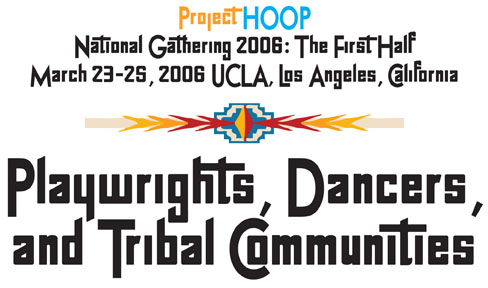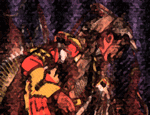DIRECTOR'S WELCOME

I am grateful to be able to welcome all of you to this fourth national convening of Native American theater and performing artists—the Project HOOP National Gathering 2006: The First Half. It’s the First Half because this year’s conference will be held in two different sessions: The First Half, March 23–26, and The Second Half is set for June 2006.
First I wish to convey my deepest gratitude to the Ford Foundation for its generous support of Project HOOP, and especially for its funding of this conference. The Project HOOP grant from Ford is part of an important initiative developed at the foundation by Ms. Betsy Theobald Richards, Cherokee tribal member and the only Native American program officer on the foundation’s staff. Ms. Richards is one of the most energetic and committed champions of Native American arts and her numerous accomplishments have created a lasting legacy. Project HOOP is one of a dozen Native American arts organizations that are receiving support from the Ford initiative. This is a major step forward for Native American arts, and we are proud to acknowledge our friend and colleague, Betsy Richards, for her contributions. Aho!
Currently, Project HOOP is in the midst of a four-year initiative to promote the development of Native American theater and performing arts in tribal communities, an ongoing goal since Project HOOP’s inception in 1996. With all of Indian Country as the target area, we are convinced that American Indian tribes and communities, both on reservations and in American cities, can benefit and thrive by working with innovative professional Native artists in their communities.
In the summer and fall of 2005, Project HOOP conducted a national performing arts needs survey. We surveyed hundreds of tribes and communities and asked a series of questions regarding the possibility of building an Indian theater in their community; What are the tribes artistic resources? Who could lead and participate? What benefits would the tribe or community receive from this work? The results were greatly encouraging: 105 tribes and numerous individiuals replied to our survey questions, and 98% of them indicated a strong interest in and need for programming that will help them develop tribal youth theaters, theater productions, new plays, dance theaters, acting classes, and playwriting workshops.
We at Project HOOP are now devising model structures and strategies for five different artists-in-residence teams that will work with communities onsite in developing a range of projects and activities of, by, and for their individual communities. In the First Half of the conference, March 23–26, we will develop the first two of these models, for dance and playwriting. The other three models, for tribal youth theater, acting workshops, and theatrical production and company start-up, will be presented at the Second Half in June. Project HOOP is currently sponsoring three pilot projects related to these team models in Billings, Montana, at Santa Clara Pueblo in New Mexico, and at the Cherokee Reservation in North Carolina. These models will be presented at the Second Half in June.
We are excited by this work, and we hope that many Native American artists will join us in this initiative. There is a lot of great work lying just ahead for all of us!
Hanay Geiogamah
Project HOOP Principal Investigator
Professor of Theater, UCLA School of Theater, Film and Television

